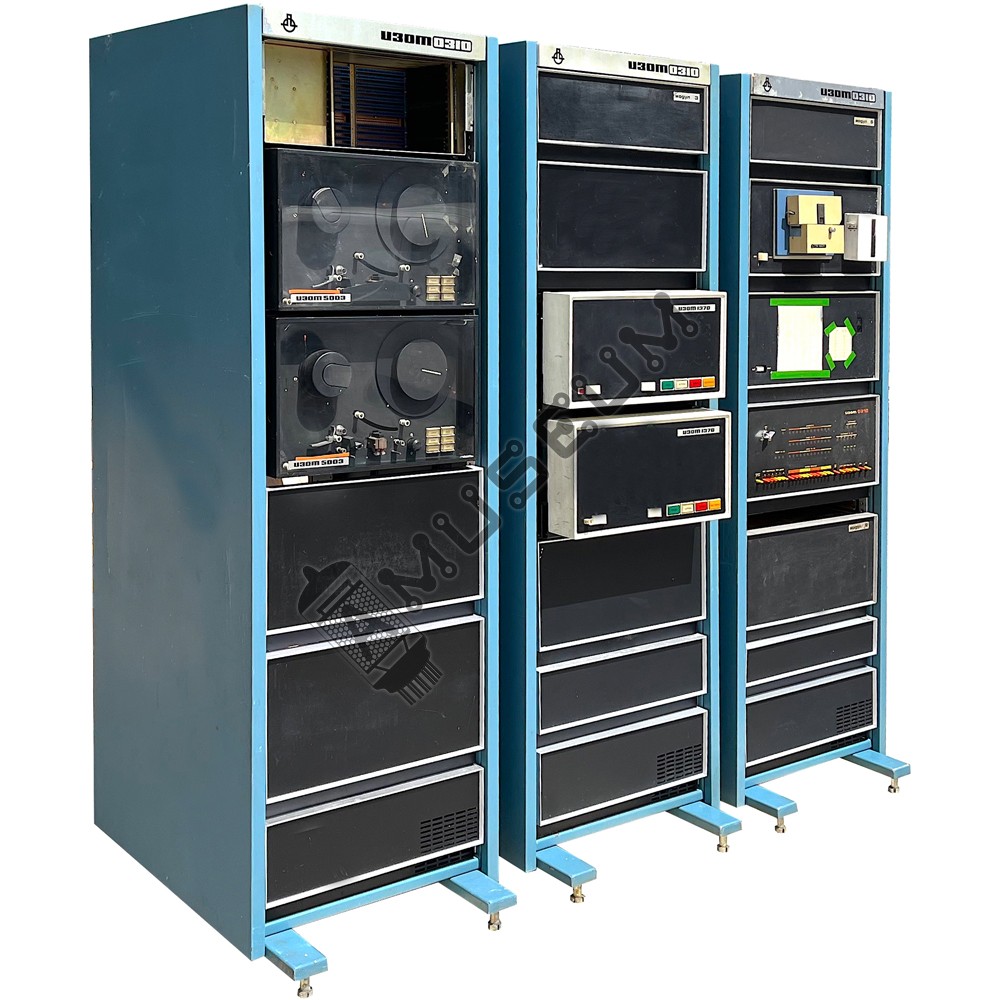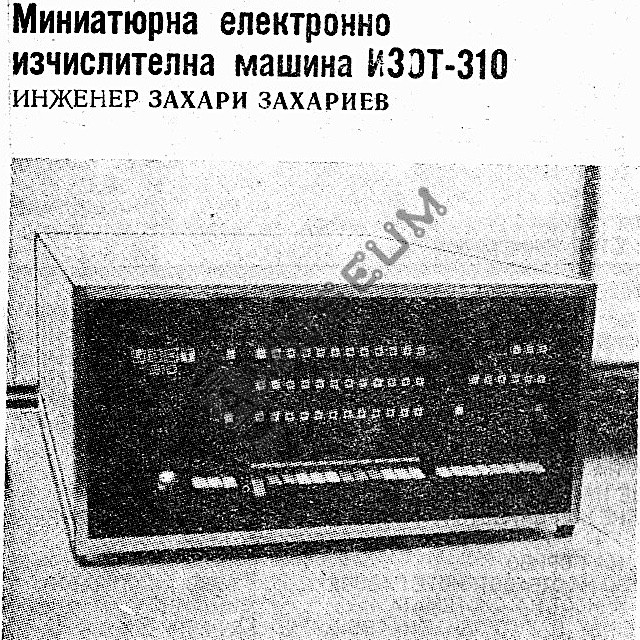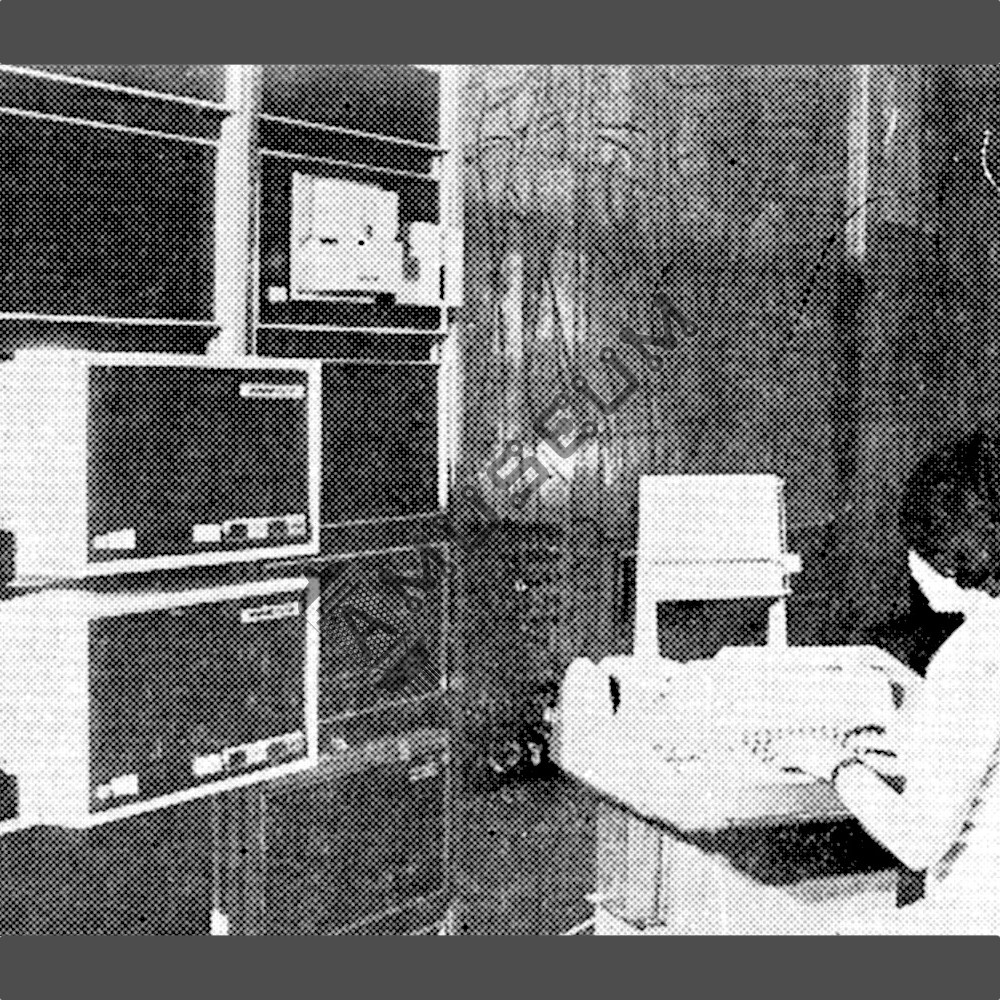Exhibit of the Amuseum
Date of inclusion in the catalogue: 26 April 2023
| Condition | Very good |
| Shown for the first time | Plovdiv Fair September 1971 (archive photo of the single module) A Polish magazine describes a demonstration at the ASU Technology Fair, October - November 1974 in Moscow. |
| Years of production |
1975 - ? |
| Units produced | ? The museum exhibit is numbered 485 from 1976 |
| Manufacturer | "Electronica" plant - Sofia |
| Power | 220 V, 50 Hz, the wattages of the individual modules in the article below, max about 3 kW. |
| Dimension and weight | 3 modules of about 300 kg each |
| Colour | Blue/black |
After many years of searching, I finally managed to come across this complete specimen with the help of a fellow collector. Another piece of Bulgarian computer history will be preserved for generations. It is accepted that this is the first Bulgarian minicomputer. It consists of three main blocks, the size of refrigerators, and additional modules. It is based on the DEC PDP 8L.
I quote an article from the RTE magazine from 1976 with a description of the machine:
IZOT 0310 SYSTEM
eng. Z. Zahariev, IIT
The IZOT 0310 system is the first Bulgarian minicomputer system developed at IIT, which has been in serial production since 1975 at the Plant "Elektronika" - Sofia. It is designed to meet the needs of the mass user in solving a wide range of information-logical, scientific-technical and economic tasks of small and medium volume, as well as for the management and automation of production processes in real time scale, complex communication-oriented systems, for training in various fields of medicine.
The versatile application of the IZOT 0310 system is provided by:
- the command system, including a wide range of logical commands and fixed-point operations;
- the presence of a standard interface, enabling a large number of peripherals with different characteristics to be connected to the system;
- construction based on the modular principle, resulting in great flexibility, reliability and maintainability of the system;
- availability of advanced software;
- the presence of high-capacity external storage devices (ESDs) and fast access to them, significantly expanding the CPU's RAM capabilities.
The IZOT 0310 system can operate in teleprocessing mode and multiprocessor systems in the presence of appropriate hardware and software. It can be used for computational and documentary work in various fields:
- in industry - for automation and control of production processes;
- in research and design institutes for solving various scientific and technical tasks;
- in medicine for the creation of relevant devices and software;- for training;- in the administrative and governmental spheres for primary information processing;- in economics - for the creation of small-type ASU or primary information processing;- for the collection of data from the industrial environment (information and dispatch systems).
The IZOT 0310 system has been developed on the basis of own research on computing systems and components of computing systems. Its individual components were developed in the LDCs and others were purchased from socialist countries.
IZOT 0310 can replace systems of the following type:
M6000 - USSR;
MERA 100, 200, 300 - Poland;
TRAI/1001 - Hungary;
PDP 8L and 8E - USA;
DATA NOVA 1200 USA; (model of the brand can be seen here)
VARIAN 620 - USA;
WANG - USA.
Only systems imported to date to PRB are listed here, but the IZOT 0310 can replace any universal minicomputer system.
TECHNICAL DATA, CHARACTERISTICS AND FEATURES OF THE SYSTEM
CPU - IZOT 0310:
Addressing - unicast
Arithmetic type - parallel in additional code
Control principle - by oddness
Control principle - schematic
Execution time per single-cycle instruction - 2 μs
Basic information unit - 12-digit word
Index registers - 8 pcs.
Operating memory:
volume - 8 k words
bit rate - 12+1 control bits
cycle - 2 μs
access time - 0,8 μs
type - ferrite
memory protection - by last page write
Number of instructions used - about 242
Maximum number of addressable control devices - up to 64
Peripheral connection organization - channel
Number of channels - 2
Multiplexer channel - 110 k words/s
Selector channel - 500 k words/s
Priority levels - up to 64
Power consumption - 750 VA
Technical features:
Information processing organization.
The processor has a highway structure, the processing of information must be concentrated in the arithmetic-logic block, and its movement is organized through its two input and one output highways. The memory (regenerating) can act simultaneously with the information processing in the arithmetic-logic block.
Format of the information - twelve-digit word of fixed length. There is a possibility to increase the accuracy when using two or more program-linked words. Addressability - the smallest addressable unit is the word. Addressing of a word from the current and null pages is done directly, and for an arbitrary word from other pages - indirectly. There is a possibility of indexing and auto-indexing by using 8 index registers.
Instruction system. Of the total number (about 200), 6 are basic with memory reference, 20 are operational without memory reference and the rest are for I/O operations.
Arithmetic operations - it is also necessary to perform arithmetic operations on fixed-point binary numbers, with a range from -1 to 1+ Operations must include addition and subtraction. Multiplication and division operations are performed programmatically.
Registers:
AK - accumulator (accumulating register for arithmetic and logic operations), 12-bit;
TPR - accumulator overflow indicator is one discharge;
BI - instruction counter, 12-digit;
AP - address register, 12-digit;
BR - buffer register (memory write information register), 12-digit;
PM - register of the number read from the operational memory, 12-digit;
RI - instruction register, 3-digit;
IR - index registers - 8;
IP - manual input register, 12-digit.
The status of the address, buffer and accumulator registers is indicated on the engineering console.
The interrupt system is implemented by a schematic path.
Organization of input/output operations - data exchange with peripheral devices is carried out using a channel organization and a standard interface, which make it possible to carry out standard dialogues and perform information exchange with a large number of diverse peripheral devices. The connection of the channel to specific data carriers (peripherals) must be carried out by means of control devices which, on the one hand, carry out standard dialogues and data exchange with the channel and, on the other hand, implement peripheral-specific control. The channel implementation is of two types:
- to work with peripheral devices with relatively low and medium data rates (multi-plex channel);
- for operation with peripherals with relatively high data rates (selector channel).
Multiplex channel - can work with slow medium-speed peripherals primarily in group or single mode and allows for 64 priority levels.
Selector channel - works with high-speed devices. It is relatively independent of the other devices on the CPU and operates in single-cycle OP occupancy mode for particularly fast peripherals and three-cycle occupancy mode (for slower peripherals). There is memory protection - by writing the last page of the OP.
Using Module 2, the OP can be expanded from 8 to 32 k words in blocks of 4 k words depending on user needs.
Operator console - teletype ASR 33, which consists of:
- alphanumeric input and output printer;
- slow punch tape reader;
- slow perforator on tape.
The control unit common to all three devices is located on a separate board in Module 1.
Alphanumeric printing device:
Type of printing - alphanumeric
Print speed - 10 symv/s
Number of characters per line - 72
Number of printed characters - 72
Number of copies - 2
Basic line spacing - 1/2"
Number of keys - 52
Information code - ACII
Slow punch on tape:
Perforation speed - 10 lines/s.
Information carrier - 5- to 8-track perforated tape
Perforation principle - electromechanical
Slow perforated tape reader:
Input speed - 10 lines/s
Information carrier - 5- to 8-track perforated tape
Reading principle - electromechanical
Power consumption - 500 VA
Fast perforated tape input device FS 1501:
Maximum input speed - 1500 lines/s
Information carrier -5- to 8-track punch tape
Tape travel after stopping at full speed - up to 1.5 mm
Reading principle - photoelectric
Number of paths - 8 + synchronous path
Power consumption - up to 200VA.
The control unit of FS 1501 is located in Module 1 and is located on a separate board.
D102 fast punch-out device:
Maximum perforation speed - minimum 90 hp/s
Information carrier -5- to 8-track tape
Perforation principle - electromechanical
Power consumption - 500 VA.
The control unit of the D102 is located in Module 1 and is located on a separate board.
Mini Magnetic Disk Storage Device (MDSD) Control Unit IZOT 1370 - Module 3:
Number of included MCDMs - up to 4
Control principle - schematic Control method - cyclic
Exchange rate with CPU - 208 k words/s
Exchange organisation with CPU - with one cycle occupation
Buffer word length - 12 digits
Power consumption - 160 VA
Record type - NRZ with dual frequency.
The IZOT 1370 is a single channel device with 16-second recording organization and the ability to transfer information only on the selector channel (with direct access to the CP OP), taking one cycle of CP operation for every 4.8 μs to transfer the completed word from/to the CP, to/from the MA.
Magnetic Disk Mini-Memory Device (MDMD) IZOT 1370:
Recording method - dual frequency NRZ
Volume of recorded information - 50 M bit (3,2 M words)
Number of cylinders - 200 +3
Number of surfaces - 4
Number of sectors - 16
Maximum access time - 80 ms
Minimum access time - 14 ms
Average access time - 45 ms
Average wait time - 12 ms
Information exchange rate - 2.5 MHz
Number of heads - 4
Number of removable cartridges - 1
Number of fixed plates - 1
Recording density - 90 bit/mm
Reliability - 5.10-9
Disk speed - 2400 rpm ±1%
Power consumption - 400 VA
The device writes and reads information from a removable disk of type EC 5269, IVM 5440 or their equivalent, which is placed on top. It shall also have a non-removable cartridge. It performs search, write, read operations and has flying read heads which are positioned by an electrodynamic linear motor.
The positioning system uses an electromagnetic sensor and an electronic servo system to hold the heads at the set address.
The movable and fixed discs are located on a common spindle connected to the DC motor axis. Air cleaned by a filter is supplied to the disc.
The unit has an interface compatible with DIABLO 43.
Control device for magnetic tape minicollectors IZOT 0310 (Module 4):
Maximum number of switched MUTUs up to 4
Write and read method NRZ-1
Control method schematic
Control method cyclic
Recording density - 32 bit/mm.
Exchange rate - 10, 20, 30, 36 k words/s
Speed of controlled tapes - 32, 64, 95, 214 cm/s
Power consumption - 160 VA
The device can operate connected to the selector channel of Module 1 in optional mode with one or three cycles occupied by the OP. It is suitable to connect minibands type IZOT 5003, IZOT 5006 and others with equivalent interface and characteristics.
MSMR IZOT 5003 magnetic stripe minitape recorder:
Information exchange rate - 10 bit/s
Recording density - 8 bit/mm
Reliability of recorded information - 10-8
Recording method - NRZ-1
Recording format:
number of tracks - 9
spacing between zones when reading - 12,6 mm when writing - 15,2 mm
Cassette diameter - 216 mm
Nominal travel speed - 32 cm/s
Rewind speed - 190 cm/s
Instantaneous speed irregularity - < 3%
Total speed irregularity - ± 2%
Start-stop time - <28 ms
ISO Compliance - P 1863
Power consumption - 240 VA
Alphanumeric mosaic printing and punch card reader control unit IZOT 0310 Module-6.
It consists of:
1. Wide mosaic printing control device having two modes of operation - start-stop and continuous.
Print speed - not less than 150 characters/s
Number of control buses between the MA and a peripheral device - not more than 8
Buffer length - 12bit
Information exchange between the CPU and the MA shall be via a software-controlled data exchange channel.
2. Control device for punch card reader:
Input speed - more than 250 cards/s
Data carrier - 80 columnar 12 position cards
Reading rate - 1
Perfocard input device IZOT 6001:
Input speed - 318 ±5% cards/min
Information carrier - 80 columnar 12 position cards.
Reading speed - 1
Reading principle - photoelectric
Form of filling the cards - columnar
Feeding magazine capacity - 600 cards
Power consumption - 150 VA
Device for wide alphanumeric mosaic printing - DZM-180
Print speed:
50 to 60 lines /min, at 10 characters/"
45 to 55 lines/min, at 12 characters/"
Code - 7 bit ISO
Power consumption - 250 VA
Power supply of all devices is from single phase mains with frequency 50±1 Hz and voltage 220 V + 10% - 15%.
System programming - the ISOT 0310 system is provided with a peripheral POS and disk DOS operating system, and is planned to have a library of standard and other programs."
End of quote
If you have more information about this exhibit, please share with the museum here.






